
Meierijstad municipality / Gemeente Meierijstad (NB)
Meierijstad ('Meierij city') is the name of a municipality in the eastern part of Noord-Brabant, formed in 2017 by merging the former municipalities of Veghel, Schijndel and Sint-Oedenrode. This page shows religious buildings in most of the places in the municipality and is mostly complete.
Meierijstad is de naam van de fusiegemeente in het oosten van Noord-Brabant waarin in 2017 de voormalige gemeenten Veghel, Schijndel and Sint-Oedenrode opgingen. Deze pagina toont religieuze gebouwen in een groot aantal van de plaatsen in de gemeente en is vrijwel compleet.
Schijndel
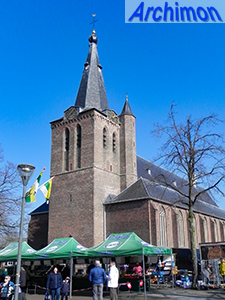 The
St. Servatius
is a three-aisled basilica, originally built in neo-Classical style in 1839-1840 and
transformed in neo-Gothic style later that century. The tower of the
medieval village church, completed in 1525, remains.
The
St. Servatius
is a three-aisled basilica, originally built in neo-Classical style in 1839-1840 and
transformed in neo-Gothic style later that century. The tower of the
medieval village church, completed in 1525, remains.
Location: Markt 17
De St. Servatius is een driebeukige basiliek, oorspronkelijk gebouwd in neoclassicistische stijl in 1839-1840 en later die eeuw in neogotische stijl verbouwd. De in 1525 voltooide toren van de middeleeuwse dorpskerk bleef behouden.
Locatie: Markt 17
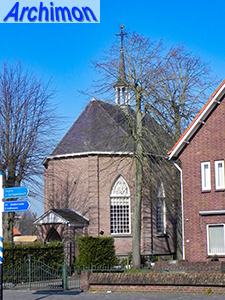
The reformed church is a church in neo-Classical style with an elongated octagonal ground-plan. It was built in 1808 as compensation for the loss of the old church, which was returned to the catholics. It was closed as a church long ago and has been used as an architect's office since 2002.
Location: Hoofdstraat 150
De hervormde kerk is een kerk in neoclassicistische stijl met een langgerekte achthoekige plattegrond. Het werd gebouwd in 1808 ter compensatie voor het verlies van de oude kerk die aan de katholieken was teruggegeven. De kerk is alweer lang geleden gesloten en huisvest sinds 2002 een architectenbureau.
Locatie: Hoofdstraat 150
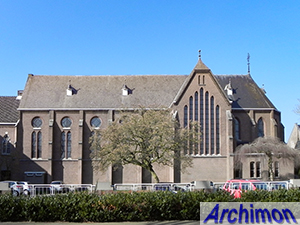 The chapel of the
former
St. Jozef convent is a cruciform building in
neo-Gothic style, designed by
J.H.J. Kayser and built in 1898.
The chapel of the
former
St. Jozef convent is a cruciform building in
neo-Gothic style, designed by
J.H.J. Kayser and built in 1898. Location: Pastoor van Erpstraat 1
De kapel van het voormalige St. Jozefklooster is een eenbeukige kruiskerk in neogotische stijl, ontworpen door J.H.J. Kayser en gebouwd in 1898.
Locatie: Pastoor van Erpstraat 1
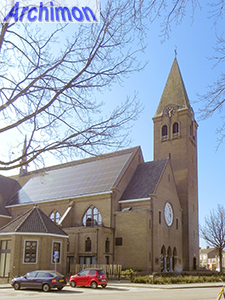 The
O.L. Vrouw van de Rozenkrans ('Our
Lady of the Rosary') in the former hamlet Boschweg is a cruciform basilica
in an Expressionist style, designed by P. Donders and C. van Liempd and built in
1928-1929. The portal and tower were added in 1954. The church was recently
rebuilt into apartments.
The
O.L. Vrouw van de Rozenkrans ('Our
Lady of the Rosary') in the former hamlet Boschweg is a cruciform basilica
in an Expressionist style, designed by P. Donders and C. van Liempd and built in
1928-1929. The portal and tower were added in 1954. The church was recently
rebuilt into apartments.Location: Boschweg 118
De O.L. Vrouw van de Rozenkrans in het voormalige buurtschap Boschweg is een kruisbasiliek in expressionistische stijl, ontworpen door P. Donders en C. van Liempd en gebouwd in 1928-1929. Het portaal en de toren werden in 1954 toegevoegd. De kerk is recentelijk verbouwd tot appartementen.
Locatie: Boschweg 118
 The chapel of the
St. Lidwina hospital is a building in Expressionist style, designed by local
architect C. van Liempd and built in 1931-1934. In 2012 it was rebuilt into apartments.
The chapel of the
St. Lidwina hospital is a building in Expressionist style, designed by local
architect C. van Liempd and built in 1931-1934. In 2012 it was rebuilt into apartments.Location: Jan van Amstelstraat 33
De kapel van het St. Lidwinaziekenhuis is een gebouw in expressionistische stijl, ontworpen door de plaatselijke architect C. van Liempd en gebouwd in 1931-1934. In 2012 werd de kapel verbouwd tot appartementen.
Locatie: Jan van Amstelstraat 33
 The
temporary church of St. Paulus was designed by
H.W. Valk and built in 1948-1949. Despite its intended temporary function it wasn't replaced by a permanent church until
1963. It became a community center itself.
The
temporary church of St. Paulus was designed by
H.W. Valk and built in 1948-1949. Despite its intended temporary function it wasn't replaced by a permanent church until
1963. It became a community center itself.ocation: Hertog Jan II laan 56
De noodkerk St. Paulus is ontworpen door H.W. Valk en gebouwd in 1948-1949. Ondanks de beoogde tijdelijke functie werd het pas in 1963 vervangen door een permanente kerk. Het werd zelf een buurthuis.
Locatie: Hertog Jan II laan 56
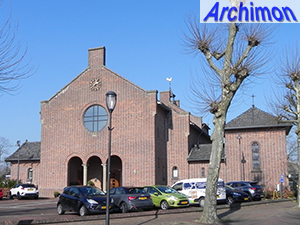 The
St. Servatius is a church in
Traditionalist style, designed by
J.J.M. van Halteren and
built in 1952 to replace a church which was destroyed in 1944.
The
St. Servatius is a church in
Traditionalist style, designed by
J.J.M. van Halteren and
built in 1952 to replace a church which was destroyed in 1944. Location: Monseigneur van de Venstraat 28
De St. Servatius is een kerk in traditionalistische stijl, ontworpen door J.J.M. van Halteren en gebouwd in 1952 ter vervanging van een kerk die in 1944 werd verwoest.
Locatie: Monseigneur van de Venstraat 28
 The chapel of the
St. Barbara convent is a small basilica, built in 1952 and designed by architects
C. van Liempd and F. van de Meerendonk in a modern Traditionalist style.
The chapel of the
St. Barbara convent is a small basilica, built in 1952 and designed by architects
C. van Liempd and F. van de Meerendonk in a modern Traditionalist style.
Location: Eerdsebaan 1
De kapel van het St. Barbaraklooster is een kleine basiliek, gebouwd in 1952 en ontworpen door architecten C. van Liempd en F. van de Meerendonk in een modern traditionalistische stijl.
Locatie: Eerdsebaan 1
Veghel
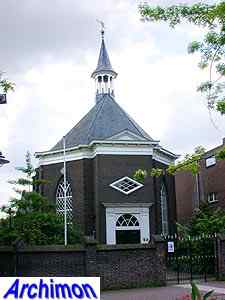
The reformed church is a church in neo-Classical style with a stretched octagonal ground-plan. It dates from 1823 and was designed by J. Schoonwater. Until 1819 the protestant minority used the medieval church, which in that year was returned to the catholics.
Location: Hoofdstraat 53
De hervormde kerk is een kerk in neoclassicistische stijl met een gerekte achthoekige plattegrond. Het gebouw dateert uit 1823 en is ontworpen door J. Schoonwater. Tot 1819 gebruikte de protestantse minderheid de middeleeuwse kerk, die in dat jaar werd teruggegeven aan de katholieken.
Locatie: Hoofdstraat 53
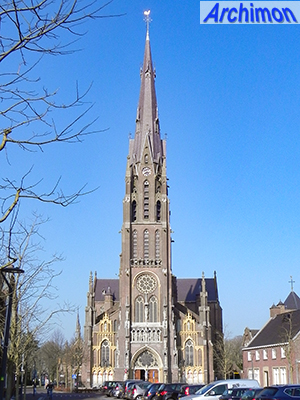
The medieval church did not last long back in the hands of the catholics. In 1860 it was demolished. A new and much bigger St. Lambertus was built in 1856-1862. It was designed by P.J.H. Cuypers and was his biggest church until then. Its design was inspired by 13th-century French Gothic.
Location: Deken van Miertstraat 2
De middeleeuwse kerk overleefde de teruggave aan de katholieken niet lang. In 1860 werd de kerk gesloopt. Een nieuwe en veel grotere St. Lambertus werd gebouwd in 1856-1862. Deze werd ontworpen door P.J.H. Cuypers en was diens grootste kerk tot dan toe. Het ontwerp is geïnspireerd door de 13e-eeuwse Franse gotiek.
Locatie: Deken van Miertstraat 2
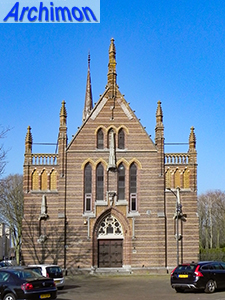
Behind the St. Lambertus we find this chapel from 1890, the Congregatiekapel, another design by P.J.H. Cuypers. For decoration horizontal lines of bricks of a light colour have been used to simulate natural stone, a typical feature of Cuypers' later work. In 1980 this chapel became a mosque.
Location: Meester van Coothstraat 1
Achter de St. Lambertus bevind zich deze kapel uit 1890, de Congregatiekapel, eveneens een ontwerp van P.J.H. Cuypers. Bij wijze van decoratie zijn horizontale lijnen van een lichtere kleur stenen gebruikt om natuursteen te simuleren, een typisch kenmerk van Cuypers'latere werk. In 1980 werd deze kapel een moskee.
Locatie: Meester van Coothstraat 1
 The
Broederkapel was built in 1923 as part of the St Anna monastery of the
Brothers F.I.C. The chapel was designed by
L.P.J. Kooken and is in
neo-Romanesque style. It is now a restaurant.
The
Broederkapel was built in 1923 as part of the St Anna monastery of the
Brothers F.I.C. The chapel was designed by
L.P.J. Kooken and is in
neo-Romanesque style. It is now a restaurant. Location: Broedershof 98
De Broederkapel is in 1923 gebouwd als onderdeel van het Sint-Annaklooster van de Gebroeders F.I.C. De kapel is ontworpen door L.P.J. Kooken en is in neoromaanse stijl. Het is nu een restaurant.
Locatie: Broedershof 98

In 1939 a Franciscan chapel was built as part of a big convent and school complex which itself had been designed by P.J.H. Cuypers and built in 1869-1872. The chapel was designed in Traditionalist style by J.J.M. van Halteren.
Location: Deken van Miertstraat 8
In 1939 werd een Franciscaanse kapel gebouwd als onderdeel van een groot zusterklooster met scholencomplex dat zelf was ontworpen door P.J.H. Cuypers en werd gebouwd in 1869-1872. De kapel werd in traditionalistische stijl ontworpen door J.J.M. van Halteren.
Locatie: Deken van Miertstraat 8
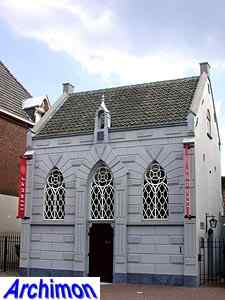
The former synagogue dates from 1865. Because after World War Two little was left of Veghel's jewish community the building was sold and became a house in 1949. In 2002-2003 the exterior of the building was restored to its original state. To achieve this the entire facade had to be rebuilt. It's now a shop.
Location: Deken van Miertstraat 1
De voormalige synagoge dateert uit 1865. Omdat er na de Tweede Wereldoorlog weinig over was van Veghels joodse gemeenschap werd het gebouw verkocht en in 1949 verbouwd tot een huis. In 2002-2003 werd de buitenkant van het gebouw in de oorspronkelijke staat hersteld. Hiervoor moest de hele gevel worden herbouwd. Het is nu een winkel.
Locatie: Deken van Miertstraat 1
Zijtaart
 The
St. Lambertus is a pseudo-basilica in neo-Gothic
style, designed by H.J. van Tulder and built in
1871.
The
St. Lambertus is a pseudo-basilica in neo-Gothic
style, designed by H.J. van Tulder and built in
1871.
Location: Pastoor Clercxstraat 69
De St. Lambertus is een pseudo-basilica in neogotische stijl, ontworpen door H.J.van Tulder en gebouwd in 1871.
Locatie: Pastoor Clercxstraat 69
 The
St.Cecilia house is a Franciscan convent in neo-Gothic style, designed by J.H.H. van Groenendael and built in 1901.
The complex now serves social and cultural purposes.
The
St.Cecilia house is a Franciscan convent in neo-Gothic style, designed by J.H.H. van Groenendael and built in 1901.
The complex now serves social and cultural purposes.
Location: Pastoor Clercxstraat 52
Het St. Ceciliahuis is een Franciscanessenklooster in neogotische stijl, ontworpen door J.H.H. Van Groenendael en gebouwd in 1901. Het complex dient tegenwoordig verschillende sociale en cukturele doeleinden.
Locatie: Pastoor Clercxstraat 52
Mariaheide
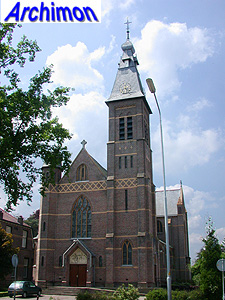 The O.L. Vrouw van Goeden Raad is a cruciform basilica in late neo-Gothic
style, designed by J.H.H. van Groenendael and built in 1907-1909. The tower and
the front were not completed until ca. 1935.
The O.L. Vrouw van Goeden Raad is a cruciform basilica in late neo-Gothic
style, designed by J.H.H. van Groenendael and built in 1907-1909. The tower and
the front were not completed until ca. 1935.
Location: Pastoor van Haarenstraat 40
De O.L. Vrouw van Goeden Raad is een kruisbasiliek in late neogotische stijl, ontworpen door J.H.H. Van Groenendael en gebouwd in 1907-1909. De toren en het front werden pas voltooid in ca. 1935.
Locatie: Pastoor van Haarenstraat 40
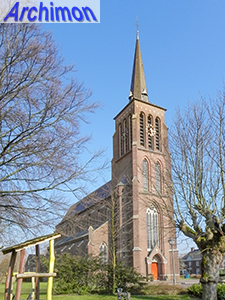 The St. Antonius Abt
is a basilica in neo-Gothic style, designed by
H.J. van Tulder and built in
1871-1872.
The St. Antonius Abt
is a basilica in neo-Gothic style, designed by
H.J. van Tulder and built in
1871-1872.
Location: Esdonkstraat 2
De St. Servatius is een basiliek in neogotische stijl, ontworpen door H.J. van Tulder en gebouwd in 1871-1872.
Locatie: Esdonkstraat 2
 The St. Antonius
van Padua
is a basilica in neo-Romanesque style, designed by
J. Margry and built in
1912.
The St. Antonius
van Padua
is a basilica in neo-Romanesque style, designed by
J. Margry and built in
1912.
Location: Morgenstraat 55
De St. Antonius van Padua is een basiliek in neoromaanse stijl, ontworpen door J. Margry en gebouwd in 1912.
Locatie: Morgenstraat 55
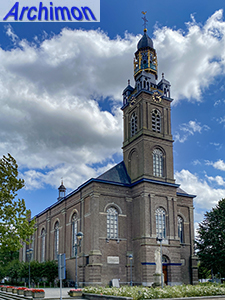 The St.
Servatius
is a hall-church in neo-Classical style, designed by
A. van Veggel and built in
1843-1844. The
The original spire was destroyed by lightning in 1896 and was replaced the
next year by the current one designed by P.J.H. Cuypers.
The St.
Servatius
is a hall-church in neo-Classical style, designed by
A. van Veggel and built in
1843-1844. The
The original spire was destroyed by lightning in 1896 and was replaced the
next year by the current one designed by P.J.H. Cuypers.
Location: Kerkstraat 1
De St. Servatius is een hallenkerk in neoclassicistische stijl, ontworpen door A. van Veggel en gebouwd in 1871-1872. De oorspronkelijke torenspits werd in 1896 door bliksem verwoest en het jaar daarna vervangen door de huidige naar een ontwerp van P.J.H. Cuypers.
Locatie: Kerkstraat 1
Sint-Oedenrode
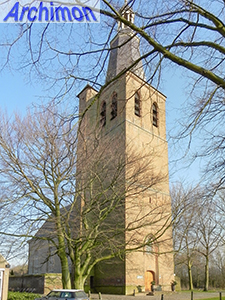 The reformed Knoptorenkerk is a small church in neo-Classical style, built
behind the tower of a 15th-century Gothic church. Parts of the walls of the
Gothic church surround the cemetery.
The reformed Knoptorenkerk is a small church in neo-Classical style, built
behind the tower of a 15th-century Gothic church. Parts of the walls of the
Gothic church surround the cemetery.
Location: Kerkdijk Noord 8
De hervormde Knoptorenkerk is een kleine kerk in neoclassicistische stijl, gebouwd achter de toren van een 15e-eeuwse gotische kerk. Delen van de muren van de gotische kerk omringen het kerkhof.
Locatie: Kerkdijk Noord 8

The St. Martinus is a neo-Gothic cruciform basilica, designed by W.Th. van Aalst and built in 1912-1915, incorporating the late 15th-century Gothic choir of the medieval pilgrimage church of St. Oda.
Location: Heuvel 1
De St. Martinus is een neogotische kruisbasiliek, ontworpen door W.Th. van Aalst en is gebouwd in 1912-1915, waarin het einde van de 15e-eeuwse gotische koor van de middeleeuwse bedevaart kerk van St. Oda.
Locatie: Heuvel 1
 The chapel of
convent and minor seminary Damianusstichting was designed by architect S. Switzar
and added to the, at that time a decade old, complex in 1933-1934. While the
chapel is generally in a more or less neo-Romanesque style, the tower has a spire
related to Expressionism.
The chapel of
convent and minor seminary Damianusstichting was designed by architect S. Switzar
and added to the, at that time a decade old, complex in 1933-1934. While the
chapel is generally in a more or less neo-Romanesque style, the tower has a spire
related to Expressionism. Location: Schijndelseweg 46
De kapel van klooster en kleinseminarie Damianusstichting is ontworpen door architect S. Switzar en in 1933-1934 toegevoegd aan het toen tien jaar oude complex. Terwijl de kapel over het algemeen in een min of meer neoromaanse stijl is, heeft de toren een spits die verwant is aan het expressionisme.
Locatie: Schijndelseweg 46

The St. Oda cemetery chapel is a small chapel in Traditionalist style, designed by Delft School leader M.J. Granpré Molière and built in 1934. It was built in honour of St. Oda, who lived and died in the village, which is named after her, in the 8th century.
Location: Kerkplein
De St. Oda begraafplaatskapel is een kleine kapel in traditionalistische stijl, door de Delftse School-leider M.J. Granpré Molière ontworpen en gebouwd in 1934. De kapel werd gebouwd ter ere van St. Oda, die in de 8e eeuw leefde en stierf in het dorp dat naar haar is vernoemd.
Locatie: Kerkplein
 The St. Antonius
van Padua is an aisleless church in neo-Romanesque style, designed by
L.J.P.
Kooken and built in 1911.
The St. Antonius
van Padua is an aisleless church in neo-Romanesque style, designed by
L.J.P.
Kooken and built in 1911. Location: Oude Lieshoutseweg 9
De St. Antonius van Padua is een zaalkerk in neoromaanse stijl, ontworpen door L.J.P. Kooken en gebouwd in 1911.
Locatie: Oude Lieshoutseweg 9
 The pilgrimage chapel
is a small open building in an eclectc style. It was built in 1927 as part of a
pilgrimage park.
The pilgrimage chapel
is a small open building in an eclectc style. It was built in 1927 as part of a
pilgrimage park. Location: Oude Lieshoutseweg 9
De bedevaartskapel is een klein open gebouw in een eclectische stijl. Het werd in 1927 gebouwd als onderdeel van een bedevaartspark.
Locatie: Oude Lieshoutseweg 9
 The St. Martinus is an aisleless church in Traditionalist style, designed by M.J.H. van Beek and
built in 1951, replacing a neo-Gothic church which had been destroyed in 1944.
The church was closed in 2018.
The St. Martinus is an aisleless church in Traditionalist style, designed by M.J.H. van Beek and
built in 1951, replacing a neo-Gothic church which had been destroyed in 1944.
The church was closed in 2018. Location: Pastoor Smitstraat 42
De St. Martinus is een zaalkerk in traditionalistische stijl, ontworpen door M.J.H. van Beek en gebouwd in 1951 ter vervanging van een neogotische kerk die in 1944 was verwoest. De kerk werd in 2018 gesloten.
Locatie: Pastoor Smitstraat 42